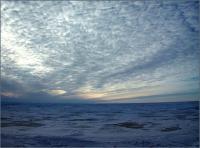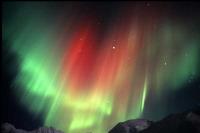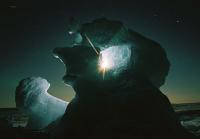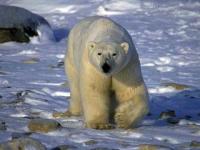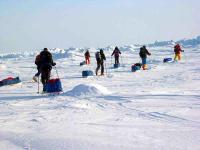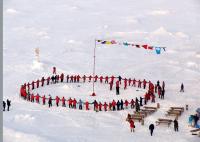North Pole definition
North Pole (Geographic North Pole, Terrestrial North Pole) is situated in the norther hemisphere where the Earth's axis of rotation meets the Earth's surface. There is a big difference between Geographic North Pole and Magnetic North Pole. The Earth's North Magnetic Pole is the point on the Earth's surface at which the Earth's magnetic field points vertically downwards. Magnetic north pole location moves constantly with time. The location of magnetic north pole was defined at 82.7°N 114.4°W in 2005. James Clark Ross was first who reached the North Magnetic Pole in June 1, 1831. The fact is that the Magnetic North Pole is physically a magnetic field south pole.
North Pole location
The North Pole is located in the middle of the Arctic Ocean which constantly covered with shifting sea ice. The North Pole latitude is 90° North. At the North Pole all lines of longitude converge there, so North Pole longitude can be defined as any degree value. Greenland is the closest land to geographic north pole (700 km / 440 mi away).
Day and Night
Sun is constantly above the horizon during the summer months (187 days) and constantly below the horizon during the winter months (178 nights) at the North Pole. There are White nights during 15-16 days before sunrise and after sunset at North Pole. Moonrise over the North Pole reminds the sunrise but it appears monthly. You can see the moon at North Pole during 2 weeks per month.
North Pole climate
North Pole weather is much warmer than in South Pole. It is situated in Polar climate zone. The average north pole temperature during winter time is -34°C (-30°F) and average North Pole summer temperature is 0°C (32°F). The temperature of North Pole changes during last 20 years. Many scientists consider it as a result of global warming. The thickness of ice at the north pole is 3-4 meters.
History of North Pole exploration
The exploration of North Pole has a long history. It is known North Pole fact that the first man who cross Arctic Circle was Greek geographer and explorer Pytheas of Massilia at about 320 BC. So he is considered a first Polar explorer. The first North Pole map was made by D. Gerasimov, Russian sailor, in the first half of XVI century. But nevertheless the main steps of North Pole discovery were made much later - in the beginning of the last century. Explorers and enthusiasts tried to achieve North Pole using all possible ways – dog sleds and planes, dirigibles and nuclear icebreakers, skis and parachutes.
It is considered that the first person in the North Pole was Robert Peary. He claimed that he reached the North Pole on April 6, 1909 together with Matthew Henson and four Inuit men. However, it is still controversial north pole fact. People, who accompanied Peary during the journey, weren't trained in navigation and couldn't independently confirm his own navigational results. The other American explorer Frederick Albert Cook stated to have reached the North Pole on April 21, 1908, but he didn't provide the convincing proof.
The new step of North Pole history started in 1937 when the Soviet high-altitude air expedition led by O.J.Schmidt made landing to drifting ices around the North Pole and had based drifting station "North Pole".
The first submarines at North Pole were American nuclear submarines "Nautilus" and "Slope" which had passed under ices of the North Pole in 1958.
However there are a lot still unknown North Pole facts and discovery of the North Pole still continues.
Animals in the North Pole
North Pole region is characterized by poor flora. There are mosses, lichens, seaweed and polar poppies in the Arctic deserts.
North pole animals are represented by species who are able to survive in difficult North Pole climate such as a polar bear, a polar fox, a polar hare, a musk ox and a reindeer in the land and a seal, a walrus, northern whale and some kinds of fish (a herring, a cod and etc.) in the sea. There are around 240 kinds of birds in North Pole, such as white partridge, a snowy owl, different kinds of seagulls, the American swan, an albatross.
Many North Pole animals can disappear because of human activity. That is why the hunting for polar bears and sea mammals is forbidden or limited in the majority of the countries which have the Arctic territories.
People in the North Pole
People from many countries made a great contribution in the history of North Pole discovery. The low temperatures of North Pole, strong winds and rough landscapes couldn't stop them.
The development of aviation in the beginning of the XX-th century has created new possibilities for North Pole exploration. The plane flights of R.Amundsen and R.Berda, the flights of dirigibles "Norway" and "Italy" are great examples of it. But for scientific researches these expeditions were not so significant. The real scientific discovery has begun after successful creation of manned drifting station North Pole-1 - the first north pole village in 1937.
Since that time the scientists and explores spend half of year in this North Pole village. The North Pole population is not so big around 150 people. Unfortunately Santa Clause doesn't live in the North Pole, but many people believe it.
You can be one among the lucky people who saw the beauty of North Pole with animals, icy landscapes, endless day and top of the world, if you join our Incredible North Pole Cruise.
Please see itinerary of this tour and don't be afraid of north pole weather our hospitality will warm you up.


